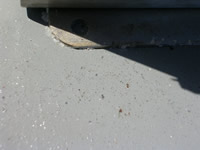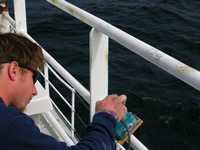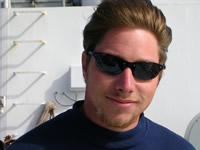


|
The Project
|
August 22, 2005
Salts in the Ocean Today the science team on the New Horizon is ready to begin the week with a series of SLOWDROP profiles in the Monterey Bay. The ship will motor to five different stations. At each of these five stations the ship will stop and the profiler will be released on the loose cable. One thing that is monitored during the profiles is the conductivity of the water. Conductivity is a measure of the dissolved salts in the water. Water that has a high conductivity is water that will easily conduct electricity. Dissolved salts provide a pathway for electric currents to travel through the water. Ocean water contains about 3% salt and this makes it highly conductive. Compare this to pure water or distilled water where there are no salts, distilled water does not conduct electricity. The conductivity probe that is sent down in the profiler is very sensitive to slight changes in conductivity. It can sense changes due to density. Salt water is heavier or denser and therefore more salts are found near the ocean bottom. Fresh water that flows into the ocean has a lot less dissolved salts. The conductivity probe in the profiler can also help a scientist see areas of fresh water flowing into the ocean from the land. Salt in the water also impacts the ship. After one week at sea, salt has begun to accumulate on almost all surfaces of the ship. Seawater splashes onto the ship as it travels through the sometimes-large ocean waves. Salt water causes iron to rust. Since the ship is made of iron, rust is a constant battle. AB (able-bodied) seaman Matt Gibson spends sometime nearly each day on the ship using a sander that is designed to sand away rust. Matt is able to sand until the metal shines like new, then he coats the metal with a special epoxy that resists rust and after 24 hours he primes and paints the metal to prevent the salts from doing further damage. Even after all that is done to prevent rust most metal surfaces on the ship need to be refinished about every two years. Matt was two years old when his father read him ‘Moby Dick’ a classic book about adventures at sea. Within months after finishing high school he got his first job on a ship. He helped in the galley (kitchen) and he was taught to do many other jobs on a ship. He has spent the last five years traveling all around the world while working on many different sea-going vessels. Matt likes going to sea and he plans to continue working and learning as a crewmember on big ocean vessels. Try this simple experiment. Add a measured amount of salt (about 1 teaspoon or 1 gram) to a measured amount of hot water (about one cup or 500 milliliters). Dissolve all the salt into the water by stirring and heating as necessary. Next heat the water in a heat-proof container until the water has all evaporated. Notice that salt is left on the bottom of the container. How much salt is left? When water evaporates into the air it leaves behind salts and other minerals. Distilled water is pure because water is heated and the steam is condensed and collected into a separate container.
|



